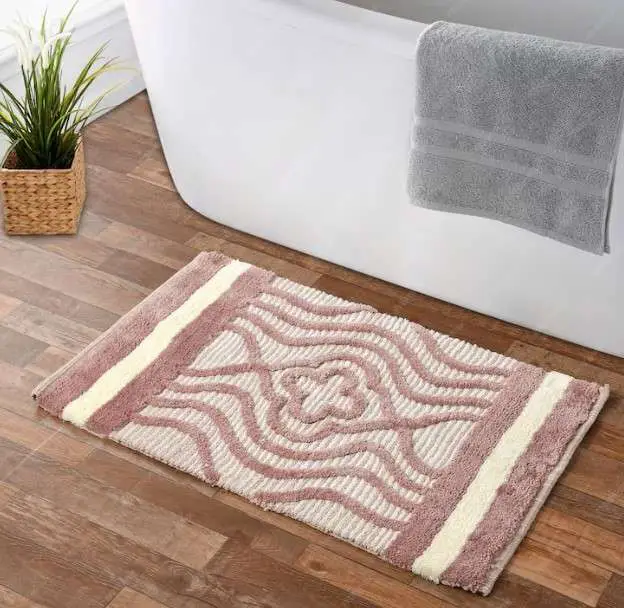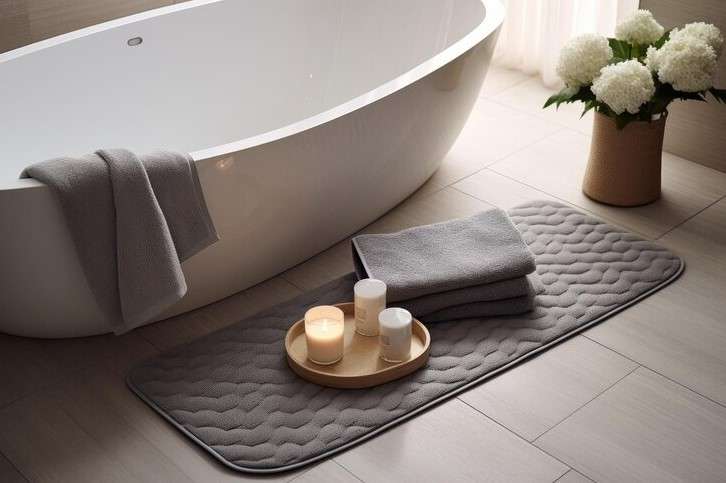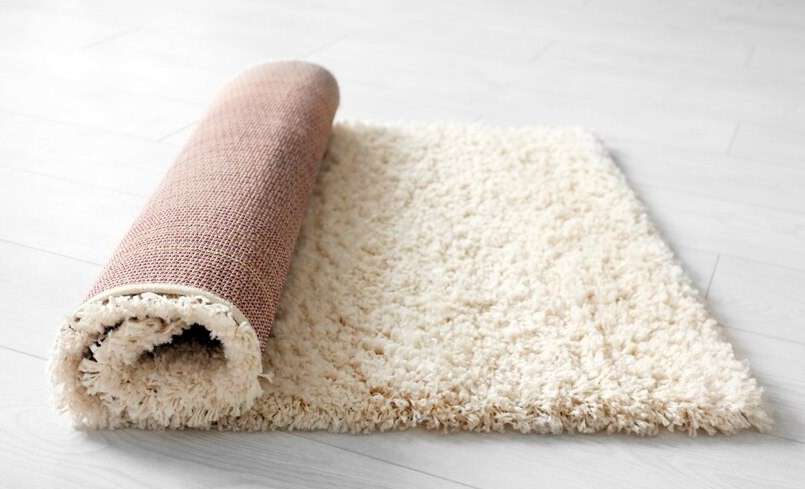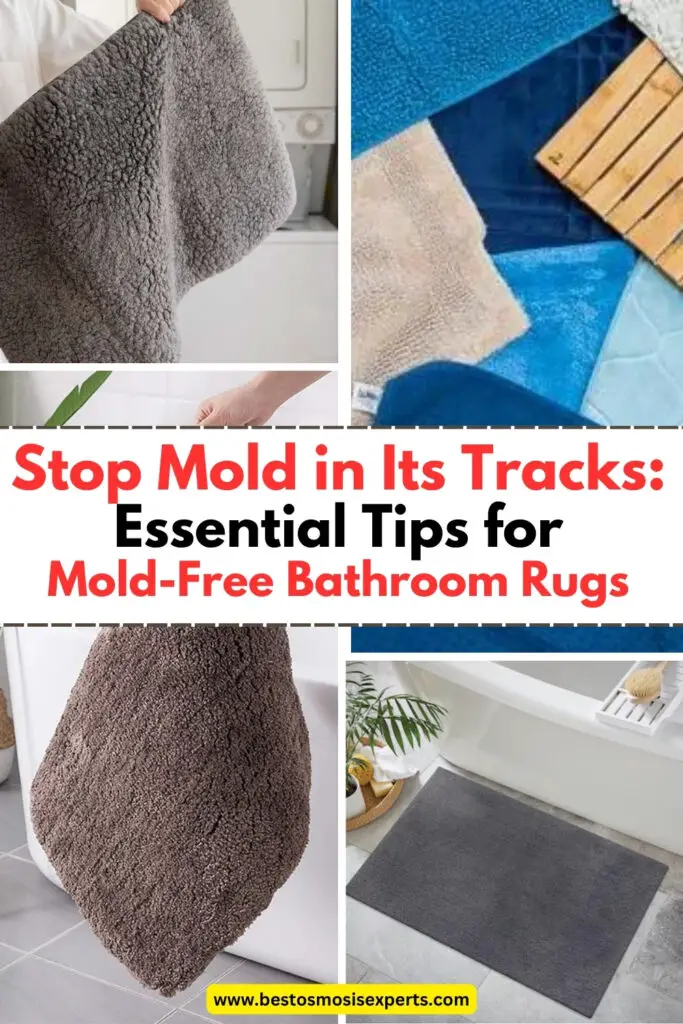Bathroom rugs not only add warmth and comfort to your bathroom space but also absorb excess water, preventing slippery floors and potential accidents. However, their constant exposure to moisture can make them a breeding ground for mold and mildew if not properly maintained.
Fear not, as we unveil five simple yet effective steps to keep mold at bay and prolong the life of your beloved bathroom rugs.
From regular cleaning routines to proper ventilation techniques, these preventive measures are easy to implement and can save you from the hassle of dealing with stubborn mold stains. By incorporating these steps into your bathroom maintenance regimen, you can enjoy a clean and hygienic environment without sacrificing style and comfort.
Ready to bid farewell to moldy bathroom rugs? Read on to discover how to keep your rugs fresh and mold-free, and get inspired to elevate your bathroom’s functionality and aesthetics.
Prevent Mold on Bathroom Rugs

Mold is a type of fungus that can grow on damp surfaces, such as bathroom rugs. Mold can cause a variety of health problems, including allergies, asthma, and respiratory infections. It can also make your bathroom look and smell bad.
There are a few simple steps you can take to prevent mold from growing on your bathroom rug.
1. Choose the Right Material
The best way to prevent mold on your bathroom rug is to choose a material that is resistant to moisture. Natural fibers, such as cotton and wool, are more absorbent than synthetic fibers, such as nylon and polyester. This means that they are more likely to hold onto moisture, which can create a breeding ground for mold.
If you have to choose a synthetic rug, look for one that is made with a moisture-wicking material. Moisture-wicking materials help to draw moisture away from the body, which can help to prevent mold growth.
2. Keep Your Rug Dry
The most important thing you can do to prevent mold on your bathroom rug is to keep it dry. This means drying it off after each use and not letting it sit wet for long periods of time.
If your bathroom rug is wet, you can dry it by hanging it up in a well-ventilated area or by using a hair dryer. You can also place a fan in the bathroom to help circulate the air and dry the rug faster.
3. Air Out Your Rug Regularly
It’s also important to air out your bathroom rug regularly. This will help to remove any moisture that may be trapped in the fibers of the rug.
To air out your rug, simply hang it up in a well-ventilated area or place it outside in the sun. You can also use a dehumidifier in your bathroom to help remove moisture from the air.
4. Clean Your Rug Regularly
Finally, it’s important to clean your bathroom rug regularly. This will help to remove any dirt, grime, and mold spores that may be present on the rug.
To clean your rug, you can use a mild detergent and water. You can also use a vinegar solution or a commercial mold cleaner. Be sure to rinse the rug thoroughly after cleaning it.
The Best Materials for Mold-Resistant Bathroom Rugs

When choosing a bathroom rug, it’s important to choose a material that is resistant to moisture and mold. Here are some of the best materials for mold-resistant bathroom rugs:
- Natural fibers: Natural fibers, such as cotton and wool, are more absorbent than synthetic fibers. This means that they are more likely to hold onto moisture, which can create a breeding ground for mold. However, natural fibers can also be treated with antimicrobial agents to help prevent mold growth.
- Synthetic fibers: Synthetic fibers, such as nylon and polyester, are less absorbent than natural fibers. This means that they are less likely to hold onto moisture, which can help to prevent mold growth. However, synthetic fibers can also be treated with antimicrobial agents to help prevent mold growth.
- Rubber: Rubber is a non-porous material that is resistant to moisture and mold. This makes it a good choice for bathroom rugs.
- Stone: Stone is a non-porous material that is also resistant to moisture and mold. This makes it a good choice for bathroom rugs.
- Metal: Metal is a non-porous material that is also resistant to moisture and mold. This makes it a good choice for bathroom rugs.
How to Clean Moldy Bathroom Rugs
If you have a moldy bathroom rug, you can clean it using a few different methods. Here are some tips:
- Use a vinegar solution: Mix equal parts vinegar and water in a bucket. Soak the moldy rug in the solution for 30 minutes. Then, scrub the rug with a brush. Rinse the rug thoroughly with water.
- Use a bleach solution: Mix equal parts bleach and water in a bucket. Soak the moldy rug in the solution for 30 minutes. Then, scrub the rug with a brush. Rinse the rug thoroughly with water.
- Use a commercial mold cleaner: Follow the directions on the product label to clean the moldy rug.
Steam clean your rug: Steam cleaning is a great way to kill mold and remove stains from your rug. - Have your rug professionally cleaned: If you have a particularly stubborn mold problem, you may want to have your rug professionally cleaned.
How to Dry Moldy Bathroom Rugs
To effectively revive moldy bathroom rugs, follow these steps for a clean and fresh outcome:
- Assess the Severity: Before diving in, evaluate the extent of mold growth. If the rug is heavily infested or the mold has spread deeply into the fibers, it might be best to replace it altogether.
- Preparation: Put on protective gear like gloves and a mask to avoid direct contact with mold spores. Take the rug outside to a well-ventilated area.
- Shake Off Excess Mold: Begin by vigorously shaking the rug to dislodge loose mold spores and debris. This step helps in reducing the initial contamination.
- Brush and Scrub: Use a stiff brush to scrub the affected areas of the rug. For stubborn mold, a mixture of water and mild detergent can be applied to aid in the cleaning process. Avoid using harsh chemicals that could damage the rug fibers.
- Sunlight Exposure: Natural sunlight is an effective mold deterrent. Lay the rug out in direct sunlight for several hours. The ultraviolet rays will help kill any remaining mold spores and eliminate musty odors.
- Dry Thoroughly: Ensure the rug is completely dry before bringing it back indoors. Hang it on a clothesline or over a sturdy railing, flipping it periodically to promote even drying. Alternatively, use a fan or dehumidifier indoors to expedite the drying process.
- Preventive Measures: To prevent future mold growth, maintain good ventilation in the bathroom, promptly address any water leaks, and wash bathroom rugs regularly to prevent moisture buildup.
By following these steps, you can effectively revive moldy bathroom rugs, ensuring a clean and hygienic environment in your bathroom.
How to Store Moldy Bathroom Rugs

Storing moldy bathroom rugs can be a challenge, but with the right approach, you can prevent further spread of mold and maintain hygiene in your living space. Firstly, ensure the rug is completely dry before storing it.
Mold thrives in damp environments, so airing out the rug in sunlight or using a dehumidifier can help eliminate moisture.
Next, thoroughly clean the rug using appropriate cleaning agents and techniques to remove any existing mold spores. Once cleaned, allow the rug to dry completely again before storing it.
Consider investing in storage solutions that promote airflow, such as breathable bags or containers with ventilation holes. Avoid storing the rug in plastic bags or airtight containers, as these can trap moisture and exacerbate mold growth.
If space allows, store the rug in a cool, dry area away from direct sunlight. Proper ventilation in the storage area is crucial to prevent moisture buildup.
Regularly inspect stored rugs for any signs of mold or moisture and take appropriate action if needed. Additionally, consider using preventive measures such as anti-mold sprays or silica gel packets to maintain a mold-free environment.
By following these steps, you can effectively store moldy bathroom rugs while minimizing the risk of further mold growth and ensuring a clean and hygienic living space.
How to Prevent Mold from Coming Back on Bathroom Rugs
To prevent mold from recurring on bathroom rugs, consistent maintenance and proper care are essential. Start by ensuring your bathroom has adequate ventilation to minimize moisture buildup, which is a prime breeding ground for mold.
After showering or bathing, leave the bathroom door or window open and run an exhaust fan to help dissipate excess humidity.
Regular cleaning is crucial.
Shake out or vacuum your rug frequently to remove any loose debris and dust that can trap moisture. If your rug is machine washable, launder it according to the manufacturer’s instructions using hot water and a mild detergent.
For non-machine washable rugs, spot clean stains promptly with a mixture of water and vinegar or a gentle detergent.
Allow your bathroom rug to thoroughly dry after cleaning. Hang it over a shower rod or clothesline in a well-ventilated area, or lay it flat outside in the sun to benefit from its natural antibacterial properties. Avoid placing a damp rug back on the bathroom floor, as this can encourage mold growth.
Consider using a moisture-resistant rug pad underneath your bathroom rug to provide an extra barrier against mold. These pads help air circulate around the rug and prevent moisture from seeping into the floor underneath.
Lastly, inspect your bathroom rug regularly for signs of mold or mildew. If you notice any discoloration or musty odors, take immediate action to clean and dry the rug thoroughly. By incorporating these simple yet effective measures into your routine, you can enjoy a clean and mold-free bathroom rug for years to come.
Conclusion
In conclusion, maintaining a mold-free environment in your bathroom is essential for both hygiene and aesthetics, and taking proactive steps to prevent mold on bathroom rugs can significantly contribute to this effort.
By following the four simple steps outlined in this guide – regular cleaning, proper drying, adequate ventilation, and periodic replacement – you can effectively minimize the risk of mold growth on your bathroom rugs.
These preventative measures not only prolong the lifespan of your rugs but also promote a healthier indoor environment by reducing the presence of allergens and potential health hazards associated with mold. Incorporating these habits into your bathroom cleaning routine will not only save you time and effort in the long run but also ensure a clean and inviting space for you and your family to enjoy.
Should I opt for machine washable or hand washable bathroom rugs to prevent mold?
When it comes to selecting the right bathroom rug to prevent mold, the choice between machine washable and hand washable options can significantly impact both convenience and effectiveness.
Opting for machine washable bathroom rugs offers a seamless solution for maintaining cleanliness and preventing mold growth. The convenience of simply tossing the rug into the washing machine allows for easy and thorough cleaning, ensuring that any moisture or bacteria harbored within the fibers are effectively eliminated. This not only saves time but also guarantees a hygienic environment in your bathroom.
On the other hand, hand washable bathroom rugs provide a more hands-on approach to cleaning, allowing you to target specific areas and stains with greater precision. While this method may require more time and effort compared to machine washing, it can be advantageous for delicate rugs or those with intricate designs that may not withstand the rigors of a washing machine.
Ultimately, the decision between machine washable and hand washable bathroom rugs depends on your priorities and lifestyle. If convenience and efficiency are paramount, machine washable rugs offer a hassle-free solution to mold prevention. However, if you prefer a more hands-on approach to cleaning or have rugs that require special care, hand washable options may be more suitable.
Regardless of your choice, regular cleaning and proper maintenance are key to preventing mold growth in bathroom rugs. By incorporating good hygiene practices and selecting the right cleaning method for your specific needs, you can enjoy a clean and mold-free bathroom environment.
Can using a bath mat underneath the rug help prevent mold?
Using a bath mat underneath a rug can indeed be a savvy strategy in the battle against mold. Let’s delve into the intricacies of why this simple addition can make a substantial difference in maintaining a mold-free environment.
Firstly, it’s essential to understand the dynamics of moisture accumulation in typical bathroom settings. Bathrooms are prone to high levels of humidity due to activities like showering and bathing.
This excess moisture can seep into the flooring, particularly in areas where rugs are placed. Without proper ventilation, this trapped moisture creates an ideal breeding ground for mold and mildew.
Now, here’s where the bath mat comes into play as a preventative measure. Bath mats are specifically designed to absorb excess moisture, acting as a barrier between the wet surface and the rug above. By placing a bath mat underneath the rug, you create an additional layer of defense against moisture infiltration.
The bath mat absorbs water droplets that may otherwise penetrate the rug, effectively reducing the risk of mold growth.
Moreover, bath mats are typically made from materials that dry quickly, further mitigating the chances of mold formation. Their absorbent nature helps to trap moisture before it has a chance to permeate the rug or underlying flooring. This not only prevents mold but also prolongs the lifespan of your rug by minimizing exposure to moisture-related damage.
In addition to its functional benefits, incorporating a bath mat underneath your rug can also enhance the aesthetic appeal of your bathroom. With a wide array of colors, patterns, and textures available, bath mats offer an opportunity to add a touch of style while safeguarding against mold.
In conclusion, the strategic placement of a bath mat beneath your rug is a practical and aesthetically pleasing solution to combat mold growth in your bathroom. By effectively managing moisture levels, you can enjoy a cleaner, healthier environment while preserving the integrity of your rug for years to come.
Should I be concerned about mold-resistant coatings or treatments for bathroom rugs?
he question of whether to invest in mold-resistant coatings or treatments for bathroom rugs is a pertinent one for anyone seeking to maintain a clean and healthy bathroom environment. Mold is a common issue in bathrooms due to the moisture-rich conditions, and it can not only cause unsightly stains but also pose potential health risks.
By opting for mold-resistant coatings or treatments for your bathroom rugs, you’re taking a proactive step in safeguarding against the proliferation of mold and mildew.
These specialized treatments are designed to inhibit the growth of mold by creating a protective barrier on the rug fibers, effectively preventing moisture absorption and providing a hostile environment for mold spores to thrive.
One of the key benefits of mold-resistant coatings or treatments is their ability to prolong the lifespan of your bathroom rugs. Mold and mildew not only compromise the aesthetic appeal of rugs but can also lead to deterioration of the fabric over time.
By investing in mold-resistant solutions, you’re not only preserving the appearance of your rugs but also ensuring their longevity, ultimately saving you time and money in the long run.
Moreover, choosing mold-resistant coatings or treatments can contribute to a healthier indoor environment for you and your family. Mold spores can exacerbate respiratory issues and allergies, particularly in individuals with sensitivities. By mitigating the risk of mold growth in your bathroom, you’re creating a safer space for everyone.
In conclusion, while it’s natural to have concerns about mold in the bathroom, opting for mold-resistant coatings or treatments for your rugs can offer peace of mind and numerous benefits. From preserving the integrity of your rugs to promoting a healthier indoor environment, investing in these solutions is a prudent choice for maintaining a clean and hygienic bathroom space.
